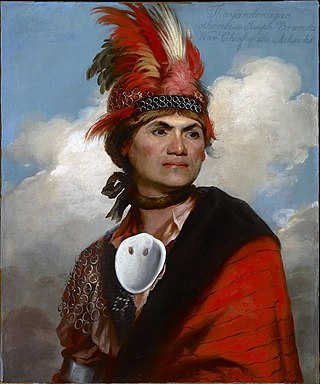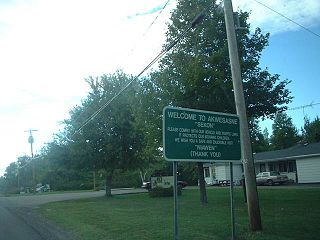
Franklin County is a county on the northern border of the U.S. state of New York. To the north across the Canada–United States border are the Canadian provinces of Quebec and Ontario, from east to west. As of the 2020 census, the county population was 47,555. Its county seat is Malone. The county is named in honor of United States Founding Father Benjamin Franklin. The county is part of the North Country region of the state.

St. Regis Mohawk Reservation is a Mohawk Indian reservation of the federally recognized tribe the Saint Regis Mohawk Tribe, located in Franklin County, New York, United States. It is also known by its Mohawk name, Akwesasne. The population was 3,288 at the 2010 census. The reservation is adjacent to the Akwesasne reserve in Ontario and Quebec across the St. Lawrence River. The Mohawk consider the entire community to be one unit and have the right to travel freely across the international border.

Mohawk or Kanienʼkéha is an Iroquoian language currently spoken by around 3,500 people of the Mohawk nation, located primarily in current or former Haudenosaunee territories, predominately Canada, and to a lesser extent in the United States. The word "Mohawk" is an exonym. In the Mohawk language, the people say that they are from Kanien:ke and that they are Kanienʼkehá꞉ka "People of the Flint Stone Place" or "People of the Flint Nation".

The Mohawk, also known by their own name, Kanien'kehà:ka, are an Indigenous people of North America and the easternmost nation of the Haudenosaunee, or Iroquois Confederacy.

The Mohawk Nation at Akwesasne is a Mohawk Nation (Kanienʼkehá:ka) territory that straddles the intersection of international borders and provincial boundaries on both banks of the St. Lawrence River. Although divided by an international border, the residents consider themselves to be one community. They maintain separate police forces due to jurisdictional issues and national laws.
Kanatsiohareke is a small Mohawk/Kanienkahaka community on the north bank of the Mohawk River, west of Fonda, New York in the traditional territory of the Kanienkahaka. The name means "The clean pots" and is derived from Canajoharie or "Upper Castle", one of the two major towns of the Mohawk nation in 1738. Kanatsiohareke was created to be a "Carlisle Indian Boarding School in Reverse", teaching Mohawk language and culture. Located at the ancient homeland of the Kanienkehaka (Mohawk), it was re-established in September 1993 under the leadership of Thomas R. Porter. The community must raise their own revenue and frequently hold cultural presentations, workshops, and academic events, including an annual Strawberry Festival. A craft shop on site features genuine handmade Native crafts from all over Turtle Island.

CKON-FM is a private radio station located in Akwesasne, a Mohawk nation territory that straddles the Canada–United States border. The station's studios are located in the Akwesasne Communication Society Building; that building is itself on both sides of the international border, with part of it being in Hogansburg, New York, and part of it in Saint Regis, Quebec. The ACS building was deliberately constructed on the international border as a symbol of Mohawk defiance between Canada and the United States, as well as an expression of communal unity.
Nancy Bonvillain is a professor of anthropology and linguistics at Bard College at Simon's Rock. She is author of over twenty books on language, culture, and gender, including a series on Native American peoples. In her field work she worked with the Kanienʼkehá꞉ka (Mohawk) and Diné (Navajo) peoples, and she has published a grammar and dictionary of the Akwesasne dialect of Kanyenʼkéha (Mohawk). She received her PhD from Columbia University in 1972 and has taught at Columbia University, The New School, SUNY Purchase, Stony Brook University, and Sarah Lawrence College. She now teaches at Bard College at Simon's Rock.
Hogansburg is a hamlet, in the Town of Bombay, in Franklin County, New York, United States. It lies on NY 37 near the Canadian-US border at the confluence of the St. Regis River with the Saint Lawrence Seaway. Hogansburg borders the St. Regis Mohawk Reservation.

Darrell Robes Kipp was a Native American educator, documentary filmmaker, and historian. Kipp was an enrolled member of the Blackfeet Nation in Montana and was instrumental in teaching and preserving the Blackfoot language as the director of the Piegan Institute.

Cornwall Island is an island in the Saint Lawrence River, directly south of the city of Cornwall. The island is located completely within Canada, but it is also part of the Akwesasne Mohawk reserve, which straddles the Canada–United States border and the Quebec–Ontario border. The Seaway International Bridge, with a channel crossing on each side of the island, provides road access to Cornwall Island from both Canada and the United States.

Native American politics remain divided over different issues such as assimilation, education, healthcare, and economic factors that affect reservations. As a multitude of nations living within the United States, the Native American peoples face conflicting opinions within their tribes, essentially those living on federally approved reservations. Interactions with the federal government and the overall American culture surrounding them influence day-to-day tribal life. Native American culture as a whole rests between the divide of the traditionalists and those who wish to trade the old ways for improved conditions.
Contemporary Native American issues in the United States are topics arising in the late 20th century and early 21st century which affect Native Americans in the United States. Many issues stem from the subjugation of Native Americans in society, including societal discrimination, racism, cultural appropriation through sports mascots, and depictions in art. Native Americans have also been subject to substantial historical and intergenerational trauma that have resulted in significant public health issues like alcohol use disorder and risk of suicide.
Sherrill Elizabeth Tekatsitsiakawa “Katsi”Cook is a Mohawk Native American midwife, environmentalist, Native American rights activist, and women's health advocate. She is best known for her environmental justice and reproductive health research in her home community, the Mohawk Nation at Akwesasne in upstate New York.
Iroquois of St Regis Indian Reserve 59 (Kawehnò:ke) is an Indian reserve in Ontario. It is part of The St Regis Indian reserve, which includes St Regis, Quebec in Quebec and St. Regis Reservation, in New York. The Iroquois of St Regis are independent of the federal and provincial governments, this division is largely for statistical purposes.
Mary Leaf (1925–2004) was an Akwesasronon basket maker, who lived on the border between Canada and the United States. Leaf specialized in basket making, having learned customary basketry techniques from her mother. Her work can be found in the collections of the Newark Museum and the National Museum of the American Indian.
The New Kituwah Academy, also known as the Atse Kituwah Academy, is a private bilingual Cherokee- and English-language immersion school for Cherokee students in kindergarten through sixth grade, located in Cherokee, North Carolina, in the Yellow Hill community of the Qualla Boundary. It is owned by the Eastern Band of Cherokee Indians (EBCI), and operated by the Kituwah Preservation and Education Program (KPEP).
Kiawenti:io Tarbell, known mononymously as Kiawentiio, is a First Nations actress and singer. She made her television debut in the third season of the CBC series Anne with an E (2019) and her film debut in Beans (2020). She currently stars as Katara in the Netflix live-action remake of Avatar: The Last Airbender (2024).
John Kahionhes Fadden was an Akwesasronon artist and educator whose artworks appeared in over 90 publications, including books, films, and periodicals. His work depicts Haudenosaunee culture and history, as well as the natural beauty of the Adirondack Mountains, where he made his home. In addition to his career as an artist, Fadden taught middle school for over three decades.








